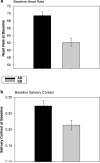Enhanced negative emotion and alcohol craving, and altered physiological responses following stress and cue exposure in alcohol dependent individuals
- PMID: 18563062
- PMCID: PMC2734452
- DOI: 10.1038/npp.2008.78
Enhanced negative emotion and alcohol craving, and altered physiological responses following stress and cue exposure in alcohol dependent individuals
Abstract
Chronic alcohol abuse is associated with changes in stress and reward pathways that could alter vulnerability to emotional stress and alcohol craving. This study examines whether chronic alcohol abuse is associated with altered stress and alcohol craving responses. Treatment-engaged, 28-day abstinent alcohol-dependent individuals (ADs; 6F/22M), and social drinkers (SDs; 10F/18M) were exposed to a brief guided imagery of a personalized stressful, alcohol-related and neutral-relaxing situation, one imagery condition per session, presented in random order across 3 days. Alcohol craving, anxiety and emotion ratings, behavioral distress responses, heart rate, blood pressure, and salivary cortisol measures were assessed. Alcohol patients showed significantly elevated basal heart rate and salivary cortisol levels. Stress and alcohol cue exposure each produced a significantly enhanced and persistent craving state in alcohol patients that was marked by increased anxiety, negative emotion, systolic blood pressure responses, and, in the case of alcohol cue, behavioral distress responses, as compared to SDs. Blunted stress-induced cortisol responses were observed in the AD compared to the SD group. These data are the first to document that stress and cue exposure induce a persistent negative emotion-related alcohol craving state in abstinent alcoholics accompanied by dysregulated HPA and physiological arousal responses. As laboratory models of stress and negative mood-induced alcohol craving are predictive of relapse outcomes, one implication of the current data is that treatments targeting decreases in stress and alcohol cue-induced craving and regulation of stress responses could be of benefit in improving alcohol relapse outcomes.
Figures



References
-
- Adinoff B, Risher-Flowers D, De Jong J, Ravitz B, Bone GH, Nutt DJ, et al. Disturbances of hypothalamic-pituitary-adrenal axis functioning during ethanol withdrawal in six men. Am J Psychiatry. 1991;148:1023–1025. - PubMed
-
- Adinoff B, Ruether K, Krebaum S, Iranmanesh A, Williams MJ. Increased salivary cortisol concentrations during chronic alcohol intoxication in a naturalistic clinical sample of men. Alcohol Clin Exp Res. 2003;27:1420–1427. - PubMed
-
- Back SE, Brady KT, Jackson JL, Salstrom S, Zinzow H. Gender differences in stress reactivity among cocaine-dependent individuals. Psychopharmacology (Berl) 2005;180:169–176. - PubMed
-
- Bar KJ, Boettger MK, Neubauer R, Groteluschen M, Jochum T, Baier V, et al. Heart rate variability and sympathetic skin response in male patients suffering from acute alcohol withdrawal syndrome. Alcohol Clin Exp Res. 2006;30:1592–1598. - PubMed
Publication types
MeSH terms
Substances
Grants and funding
LinkOut - more resources
Full Text Sources
Other Literature Sources
Medical
Research Materials

